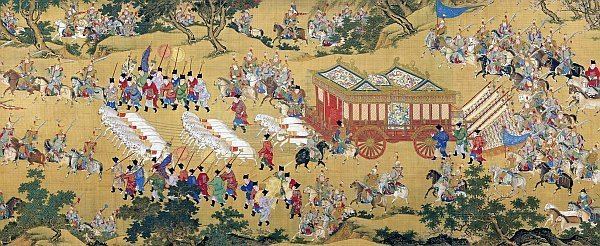 | ||
Six Dynasties (Chinese: 六朝; Pinyin: Liù Cháo; 220 or 222–589) is a collective term for six Chinese dynasties in China during the periods of the Three Kingdoms (220–280 AD), Jin dynasty (265–420), and Southern and Northern Dynasties (420–589). It also coincides with the era of the Sixteen Kingdoms (304-439).
Contents
- Six Dynasties with capitals in Jiankang
- Six Dynasties with legitimate lineage
- Poetry in the Six Dynasties
- Legacy
- References
This era immediately followed the fall of the Han Dynasty in 220 AD, and was an era of disunity, instability and warfare.
The term generally refers to two groupings of dynasties during that period:
Six Dynasties with capitals in Jiankang
The six dynasties were:
- Eastern Wu (222–280)
- Eastern Jin Dynasty (317–420)
- Liu Song Dynasty (420–479)
- Southern Qi (479–502)
- Liang Dynasty (502–557)
- Chen Dynasty (557–589)
This listing is based on the states that maintained national capitals at Jiankang (contemporary Nanjing) near the Yangzi River (Chang Jiang). Xu Song (许嵩, Xǔ Sōng) in Tang Dynasty wrote a book, Jiankang Shilu (建康实录, Jiànkāng Shílù), that provides a historical account of Jiankang, which gave rise to this scheme of naming.
Six Dynasties with legitimate lineage
These six dynasties were:
- Cao Wei (220–265)
- Jin Dynasty (265–420)
- Liu Song Dynasty (420–479)
- Qi Dynasty (479–502)
- Liang Dynasty (502–557)
- Chen Dynasty (557–589)
Sima Guang, in his book Zizhi Tongjian, used the era names of these six dynasties as the timeline to describe this period of history. Later Chinese called this period the Six Dynasties period, or Wei Jin Southern and Northern Dynasties (魏晋南北朝, Wèi Jìn NánběiCháo).
Poetry in the Six Dynasties
The Six Dynasties was an important era in the history of Chinese poetry, especially remarkable for its frank (for Classical Chinese poetry) descriptions of love and beauty. Especially important, and frequently translated into English, is the anthology New Songs from the Jade Terrace, compiled by Xu Ling (507-83), under the patronage of Crown Prince Xiao Gang (Later Emperor Jian Wen) of the Liang Dynasty. Also significant, is the Zi Ye, or "Lady Midnight" style, supposedly originating with an eponymously named fourth-century professional singer of the Jin dynasty.
Legacy
As the first time in history that major political center of China being located to the south, with surge in population and continual development of economy and culture, this transformed southern China from being remote territories to the economic center that can rival the north from Tang Dynasty onward.
Buddhism, which first reached China in Eastern Han Dynasty, flourished in the Six Dynasties (and simultaneously in the Northern Dynasties) and became a major religion in China since then.
The Japanese scholar Tanigawa Michio analyzed the Six Dynasty period to test general theories of China's historical development. Some thinkers, Tanigawa writes, argue that China followed the set European pattern which Marxists and liberal thinkers thought to be universal, that is, from ancient slavery to medieval feudalism to modern capitalism, while others argue that "Chinese society was extraordinarily saturated with stagnancy, as compared to the West, and they assume that it existed in a qualitatively different historical world from Western society." That is, there an argument between those who see "unilinear, monistic world history" and those who conceive of a "two-tracked or multitracked world history." Tanigawa's conclusion is that China did not have "feudalism" in the sense that Marxists use, but that the military governments did not develop a military aristocracy of the sort that developed in Europe. The period established social and political patterns which shaped China's history from that point on.
